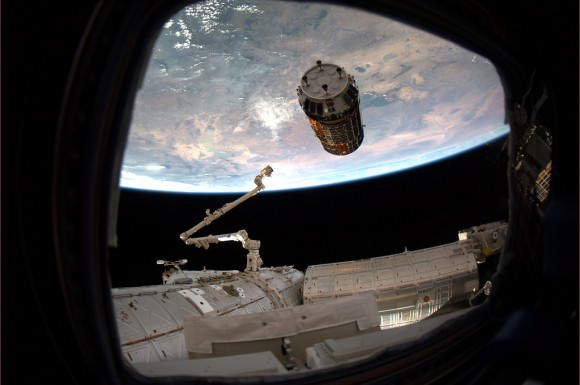[/caption]
Japan’s HTV-2 Kounotori resupply ship undocked from the International Space Station at 15.45 GMT on March 28, and will burn up in Earth’s atmosphere sometime early Wednesday March 31. Back in January, the craft brought five metric tons of equipment and supplies to the station, but now it is loaded with trash and unneeded equipment and packing materials. Most of the HTV will likely disintegrate as it passes through the atmosphere, but any pieces left over will find a watery grave in a remote area in the Central Pacific. But sensors on board the HTV-2 will provide data on how the craft behaves during its fiery demise.
The Re-entry Breakup Recorder (REBR) will record temperature, acceleration, rotational rate and other data.
The second HTV from Japan arrived at the ISS on January 27 carrying its cargo of food, water supplies, and equipment. Japan expects to send another seven cargo ships to the station by 2015, with the next one scheduled to arrive in January 2012.
The ISS crew grappled HTV-2 with the Canadarm 2, undocked it from the station and then maneuvered the HTV into a release position about 30 feet below the station. The Space Station Integration and Promotion Center in Tsukuba, Japan was able to handle the commands to activate and check out the freighter’s guidance, navigation and control systems. Because of the March 11 earthquake in Japan, controls of the HTV and Japan’s Kibo laboratory was temporarily handed over to NASA in Houston, but the center is now fully restored for full commanding, telemetry and voice capabilities for the ISS.
The cargo ship will enter the atmosphere on Wednesday at 03.09 GMT, and any remaining fragments will fall into the Pacific Ocean 31 minutes later.
So long Konotori, and we thank you.


Dumping into the ocean/atmosphere from space, ugh. Can’t we do something better when there are such things out there as, I don’t know, all of space?
It’s much easier and needs less energy (and therefore rocket fuel) to throw into the atmosphere than to shoot it into outer space.
You would have to carry that extra fuel during launch, reducing the mass you could use for useful things like food.
And since it mostly burns up during reentry, it poses no real risk to anything on or below the earth’s surface.
Electric motor, kinetic energy? Let’s install a trash cannon on the ISS. =D
I know the easier option is just dropping it into the atmosphere, and I know relative to other pollutants this is probably very minor. It’s all cumulative though, and every bit of reduction is good. If we never find a cleaner way of going about disposing of things in space and there are more things and people in space (which I hope for), the amount of stuff being disposed of just scales along with it.
What would be an ideal way to dispose of things in space rather than dumping them back on the planet, and that would require the most reasonable amount of energy? The Sun? Jupiter? Localized vaporization? What if you just compacted it and used a solar collector to burn it up on the ISS? Might even generate a bit of thrust. Trash Engine Mark 1. Toss a solar sail on it, those are pretty weight efficient right?
I mean, you all are too cute trying to do thing with this so called “trash.” But I am afraid that bulk of this “trash” is most likely, you know, tons of brown stuff that get dumped after astronauts consume tons of that supplies!
These are early days, and ISS is the first station that will generate enough trash to be noticeable. As Emilio says, some of this will be useful when closing long-time systems, it will be reworked which will diminish trash from both ends. (Fewer launchers.)
So I expect the bulk of the biomass will be out of the equation eventually. It will take time (current mini-biosphere closure is a mere ~ 70 % tops – not that you need full closure to start), but no immediate need to change procedures.
As for the technology items, that depends. Feasibly some can stay in orbit if there will be more stations (such as hotels) to be reused in some form or other. But mechanics says the rest should go (due to need to periodically re-boost LE orbiters).
When there will be less one off resupply ships to dump into the atmosphere, you want to recycle them too for affordability, I expect some technology along the lines you propose will be developed. That will be around the next generation (20-30 years) at a guess; even if say ESA starts to figure in ATV landing capability any time soon, it will take several years to develop.
I forgot: something that would speed things up is to have LEO tourism and hotels. They would like to “go green” in the current society, so will develop & use landing capability (say, Dragon) sooner.
I’d say the moon. It’s actually quite hard to get something on a track closer to the sun (MESSENGER took 6 years to go to Mercury! — ok, 6 years in order to settle into orbit. It visited Mercury twice before, IIRC). Many spacecraft that want to visit the Sun use Jupiter (!!) for the correct course.
Personally I wouldn’t care if it took our poop 1000 years to get to the Sun as long as it doesn’t get in our way for anything, unless it could be useful. No ideas there. 😉
“and now for today’s weather forcast: sh*t showers over the pacific and a chance you’d catch an astronaut’s pee drop later this week!”
i love the side effects of science! 🙂